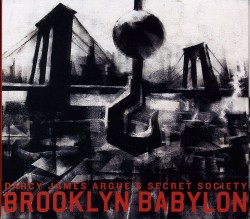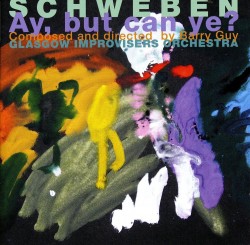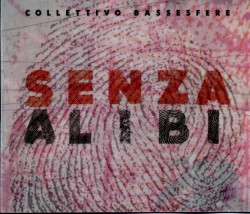Fuelled by innovation rather than nostalgia, composers and arrangers continue to utilize the sonic parameters of larger ensembles to help tell their stories in the most expansive way possible. Whether it’s exposing individual original compositions or organizing the sessions into a thematic whole, these vital CDs demonstrate why a big band is still favoured as an expressive vehicle for both free-form improvisation and tightly plotted compositions.
 For an example of the latter you don’t have to go much further than Brooklyn Babylon (New Amsterdam Records NWAM 048 newamsterdamrecords.com), a mythical and cinematic narrative created by Vancouver-born Darcy James Argue as part of a multi-media presentation by Croatian-born visual artist Danijel Zezelj. Argue, who also lived in Montreal and received his degree in composition in Boston, has been in Brooklyn since 2003 and composed the multi-part Brooklyn Babylon as a fable, reflecting his adopted hometown’s storied past, cultural multiplicity and ambitious future. Conducted by the composer, Argue’s 18-piece Secret Society band performs the suite’s eight interlocking themes and seven brief interludes. Calling on the talents of a band featuring the interlocked groove of drummer Jon Wikan and bassist Matt Clohesy, the storytelling understatement of several reed soloists, and the alternately plunger excitement and mellow narratives of fellow Canuck trumpeter Ingrid Jensen, Argue directs a sound picture with enough expansive exposition to make the CD the equivalent of aural Technicolor. Reflecting present-day currents of New York`s second borough, the sequences in Argue’s suite blend and contrast vamping big-band section work; heavily rhythmic rock-music-like grooves; gentle folkloric and impressionistic sound pastels from flute, soprano sax and flugelhorn soloists; plus interludes that replicate brass band marches, Balkan ballads, a touch of electronic processing and the pre-recorded sounds of the borough’s streets. One standout is Missing Parts when the rest of the band members play hand percussion backing Josh Stinson’s free-form baritone sax lines and a mellow trombone interlude from James Hirschfield. Another is The Tallest Tower in the World, which reaches its heights through brassy trumpet triplets and soprano sax squeals. Keyboardist Gordon Webster holds components together not only with sharp piano cadenzas but also with near-vocalized melodic sweeps. If the program does have a weakness it probably lies in its movie soundtrack-like surround sound expressiveness. With piccolo peeps and French horn lowing heard more often than tuba burps or guitar note shredding, the selections often retreat to overly pleasant background sounds lacking the authoritative ingredients that would define them as completely individual. But Argue is still developing. Maybe he’ll soon compose a piece to reflect his homeland.
For an example of the latter you don’t have to go much further than Brooklyn Babylon (New Amsterdam Records NWAM 048 newamsterdamrecords.com), a mythical and cinematic narrative created by Vancouver-born Darcy James Argue as part of a multi-media presentation by Croatian-born visual artist Danijel Zezelj. Argue, who also lived in Montreal and received his degree in composition in Boston, has been in Brooklyn since 2003 and composed the multi-part Brooklyn Babylon as a fable, reflecting his adopted hometown’s storied past, cultural multiplicity and ambitious future. Conducted by the composer, Argue’s 18-piece Secret Society band performs the suite’s eight interlocking themes and seven brief interludes. Calling on the talents of a band featuring the interlocked groove of drummer Jon Wikan and bassist Matt Clohesy, the storytelling understatement of several reed soloists, and the alternately plunger excitement and mellow narratives of fellow Canuck trumpeter Ingrid Jensen, Argue directs a sound picture with enough expansive exposition to make the CD the equivalent of aural Technicolor. Reflecting present-day currents of New York`s second borough, the sequences in Argue’s suite blend and contrast vamping big-band section work; heavily rhythmic rock-music-like grooves; gentle folkloric and impressionistic sound pastels from flute, soprano sax and flugelhorn soloists; plus interludes that replicate brass band marches, Balkan ballads, a touch of electronic processing and the pre-recorded sounds of the borough’s streets. One standout is Missing Parts when the rest of the band members play hand percussion backing Josh Stinson’s free-form baritone sax lines and a mellow trombone interlude from James Hirschfield. Another is The Tallest Tower in the World, which reaches its heights through brassy trumpet triplets and soprano sax squeals. Keyboardist Gordon Webster holds components together not only with sharp piano cadenzas but also with near-vocalized melodic sweeps. If the program does have a weakness it probably lies in its movie soundtrack-like surround sound expressiveness. With piccolo peeps and French horn lowing heard more often than tuba burps or guitar note shredding, the selections often retreat to overly pleasant background sounds lacking the authoritative ingredients that would define them as completely individual. But Argue is still developing. Maybe he’ll soon compose a piece to reflect his homeland.
 Another accomplished composer who moved from another country and become established in a jazz scene is Estonian alto saxophonist Maria Faust, now a resident of Denmark. Her 15-piece band made up of Scandinavian and Baltic players, performs six of her compositions on Jazz Catastrophe (Barefoot Records BFREC025 barefoot-records.com). Startlingly, but not unexpectedly, the music is a complete negation of the title’s sentiment. Unlike some of Brooklyn Babylon’s glummer passages, excitement is Jazz Catastrophe’s watchword. Granted this CD is shorter than Argue’s and isn’t programmatic, but it’s still alive with burning swing out of which pop energetic solos. Take Superhero Trauma Center for instance. Beginning with emphasized downbeats from the entire group, the tremolo motion is slowly pushed aside by hand taps, crunches and slurred fingering from guitarist Stephan Sieben which intermingle with electronic implements’ quivers, then are succeeded by layers of agitated horn riffs. In contrast Figaro evolves slowly and stealthily, with Henrik Pultz Melbye’s baritone saxophone blasts complementing the composer’s moody, moderato alto solo chugging atop percussion echoes. Other pieces showcase gutbucket blowing from trombonist Jens Kristian Bang; cleverly harmonized reed expositions; and a pointed demonstration of how Qarin Wikström’s wordless vocalizing is expressed in tandem with band sequences without either overpowering the other. Vladimir, the most experimental line, is a celebration of low-pitches. Tubaist Kristian Tangvik’s pedal-point blats and Sture Ericson’s lustrously modulated bass clarinet timbres are followed by a dynamic swing sequence from bassists Adam Pultz Melbye and Nils Bo Davidson before the narrative shatters into strident, high-register reed shrills.
Another accomplished composer who moved from another country and become established in a jazz scene is Estonian alto saxophonist Maria Faust, now a resident of Denmark. Her 15-piece band made up of Scandinavian and Baltic players, performs six of her compositions on Jazz Catastrophe (Barefoot Records BFREC025 barefoot-records.com). Startlingly, but not unexpectedly, the music is a complete negation of the title’s sentiment. Unlike some of Brooklyn Babylon’s glummer passages, excitement is Jazz Catastrophe’s watchword. Granted this CD is shorter than Argue’s and isn’t programmatic, but it’s still alive with burning swing out of which pop energetic solos. Take Superhero Trauma Center for instance. Beginning with emphasized downbeats from the entire group, the tremolo motion is slowly pushed aside by hand taps, crunches and slurred fingering from guitarist Stephan Sieben which intermingle with electronic implements’ quivers, then are succeeded by layers of agitated horn riffs. In contrast Figaro evolves slowly and stealthily, with Henrik Pultz Melbye’s baritone saxophone blasts complementing the composer’s moody, moderato alto solo chugging atop percussion echoes. Other pieces showcase gutbucket blowing from trombonist Jens Kristian Bang; cleverly harmonized reed expositions; and a pointed demonstration of how Qarin Wikström’s wordless vocalizing is expressed in tandem with band sequences without either overpowering the other. Vladimir, the most experimental line, is a celebration of low-pitches. Tubaist Kristian Tangvik’s pedal-point blats and Sture Ericson’s lustrously modulated bass clarinet timbres are followed by a dynamic swing sequence from bassists Adam Pultz Melbye and Nils Bo Davidson before the narrative shatters into strident, high-register reed shrills.
 An old hand at adapting program music for a large ensemble of improvisers is bassist Barry Guy, who has directed the London Jazz Composers Orchestra since 1970. Schweben - Ay But Can Ye? (Maya Records MCD 1201 maya-recordings.com) is particularly noteworthy since Guy’s composition for the 22-piece Glasgow Improvisers Orchestra (GIO) links a Wassily Kandinksy painting to a poem by his Soviet contemporary Vladimir Mayakovsky and that verse’s translation into Scots dialect by Edwin Morgan (1920-2010), Scotland’s national poet. No academic exercise, Guy’s suite melds dissonant timbres of Scots phraseology with polyphonic gyrations from solo, group or dual instrumental combinations. Variants of the poem are heard at intervals during the nearly 48-minute performance, but since most words, phrases and sentences are swallowed or strained from the throats of Nicola MacDonald and Aileen Campbell, birth near the River Clyde would seem to necessary for full understanding of the meaning – an impression confirmed by an earlier track where Morgan reads the poem. With verbal comprehension ruptured, attention moves to the vocalists’ tessitura, which includes bel canto warbling and lyrical scene-setting. Meantime GIO members’ virtuosity is given full reign, including harsh rasgueado from the harpist, angled friction from the violinists and bassists, wide-bore brass snorts, slurping and stabbing reed lines, staccato flute rasps and broadly emphasized piano glissandi. The earliest variation concludes with a warm interlocking of voice syllables and tutti orchestral quivers. This imaginative balance continues throughout subsequent sequences as stentorian rhythms from dual percussionists and quivers from the layered background arrangement pull back at junctures for emotional vocalese or descriptive drama from trombone blats, crashing cymbals or crisp accelerating saxophone vamps from Raymond Macdonald and John Burgess. Finally the sonic hegemony reaches a writhing crescendo where the reeds’ whistled and angled split tones, each more jagged and atonal than the previous one, make common cause with the verbal jabberwocky. Overall the evenly distributed orchestral passages plus heartfelt individual solos illuminate the poem(s) plus painting more than the vocalists’ garbled phrases. A fascinating coda has Morgan discussing Mayakovsky’s influence on his poetics.
An old hand at adapting program music for a large ensemble of improvisers is bassist Barry Guy, who has directed the London Jazz Composers Orchestra since 1970. Schweben - Ay But Can Ye? (Maya Records MCD 1201 maya-recordings.com) is particularly noteworthy since Guy’s composition for the 22-piece Glasgow Improvisers Orchestra (GIO) links a Wassily Kandinksy painting to a poem by his Soviet contemporary Vladimir Mayakovsky and that verse’s translation into Scots dialect by Edwin Morgan (1920-2010), Scotland’s national poet. No academic exercise, Guy’s suite melds dissonant timbres of Scots phraseology with polyphonic gyrations from solo, group or dual instrumental combinations. Variants of the poem are heard at intervals during the nearly 48-minute performance, but since most words, phrases and sentences are swallowed or strained from the throats of Nicola MacDonald and Aileen Campbell, birth near the River Clyde would seem to necessary for full understanding of the meaning – an impression confirmed by an earlier track where Morgan reads the poem. With verbal comprehension ruptured, attention moves to the vocalists’ tessitura, which includes bel canto warbling and lyrical scene-setting. Meantime GIO members’ virtuosity is given full reign, including harsh rasgueado from the harpist, angled friction from the violinists and bassists, wide-bore brass snorts, slurping and stabbing reed lines, staccato flute rasps and broadly emphasized piano glissandi. The earliest variation concludes with a warm interlocking of voice syllables and tutti orchestral quivers. This imaginative balance continues throughout subsequent sequences as stentorian rhythms from dual percussionists and quivers from the layered background arrangement pull back at junctures for emotional vocalese or descriptive drama from trombone blats, crashing cymbals or crisp accelerating saxophone vamps from Raymond Macdonald and John Burgess. Finally the sonic hegemony reaches a writhing crescendo where the reeds’ whistled and angled split tones, each more jagged and atonal than the previous one, make common cause with the verbal jabberwocky. Overall the evenly distributed orchestral passages plus heartfelt individual solos illuminate the poem(s) plus painting more than the vocalists’ garbled phrases. A fascinating coda has Morgan discussing Mayakovsky’s influence on his poetics.
 Another group which also utilizes electronics and sort of vocals is Collettivo Bassesfere. But on Senza Alibi (Collettivo Bassesfere 85015 myspace.com/bassesfere), this collection of Bologna’s top jazzers mostly uses their instrumental smarts to create a program of post-modern, unhackneyed swing. The voices heard are frequently almost inaudible, making sardonic comments in Italian or harmonized with the instruments. That is except for one instance when Vincenzo Vasi begins Il Niente e il poco impersonating a sappy nightclub crooner whose overripe delivery is gently mocked by clanks and clips from pianist Fabrizio Puglisi and vibes player Pasquale Mirra. Here though, the narrative’s spirit comes through with a mid-section call and response from brass and reeds. More fundamental is the 15-minute, Vasi-composed Negato, divided among granular electronic quivers from the composer, Alberto Capelli’s scene-stealing guitar licks and an agitated tenor saxophone solo from Edoardo Marraffa. As the exposition lurches from a TV-detective-like soundtrack beat from the dual bassists to a pseudo-psychedelic freakout via two saxists and the guitarist, Puglisi and Mirra’s sympathetic teamwork brings the proceedings to a satisfactory conclusion. Puglisi’s composition Violet Sunrise indicates that the collective can reflect moods as well as themes; while the tenor saxophonist’s Alice establishes what a late swing band would sound like with free-form soloists. Throughout the first intermezzo the pianist’s self-limiting chording suggests he’s reaching for a termination that never arrives. Meanwhile Mirra’s metallic sweeps follow a similar course, as the ambiance is heightened with arco bass scrubs. Fifties big band members would recognize the accents and groove on Alice, but the solos evolve a half-century further. Besides guitar grinds, bass thumb-pops, jittery signal processing and wriggling synthesizer screeds, Marraffa’s harsh multiphonics and tone augmentation reflect the advances of Albert Ayler and John Coltrane.
Another group which also utilizes electronics and sort of vocals is Collettivo Bassesfere. But on Senza Alibi (Collettivo Bassesfere 85015 myspace.com/bassesfere), this collection of Bologna’s top jazzers mostly uses their instrumental smarts to create a program of post-modern, unhackneyed swing. The voices heard are frequently almost inaudible, making sardonic comments in Italian or harmonized with the instruments. That is except for one instance when Vincenzo Vasi begins Il Niente e il poco impersonating a sappy nightclub crooner whose overripe delivery is gently mocked by clanks and clips from pianist Fabrizio Puglisi and vibes player Pasquale Mirra. Here though, the narrative’s spirit comes through with a mid-section call and response from brass and reeds. More fundamental is the 15-minute, Vasi-composed Negato, divided among granular electronic quivers from the composer, Alberto Capelli’s scene-stealing guitar licks and an agitated tenor saxophone solo from Edoardo Marraffa. As the exposition lurches from a TV-detective-like soundtrack beat from the dual bassists to a pseudo-psychedelic freakout via two saxists and the guitarist, Puglisi and Mirra’s sympathetic teamwork brings the proceedings to a satisfactory conclusion. Puglisi’s composition Violet Sunrise indicates that the collective can reflect moods as well as themes; while the tenor saxophonist’s Alice establishes what a late swing band would sound like with free-form soloists. Throughout the first intermezzo the pianist’s self-limiting chording suggests he’s reaching for a termination that never arrives. Meanwhile Mirra’s metallic sweeps follow a similar course, as the ambiance is heightened with arco bass scrubs. Fifties big band members would recognize the accents and groove on Alice, but the solos evolve a half-century further. Besides guitar grinds, bass thumb-pops, jittery signal processing and wriggling synthesizer screeds, Marraffa’s harsh multiphonics and tone augmentation reflect the advances of Albert Ayler and John Coltrane.
As long as groups of musicians want to play together guided by their own sonic desires and canny arrangements, large ensembles will continue to flourish in the jazz and improvised music worlds.



